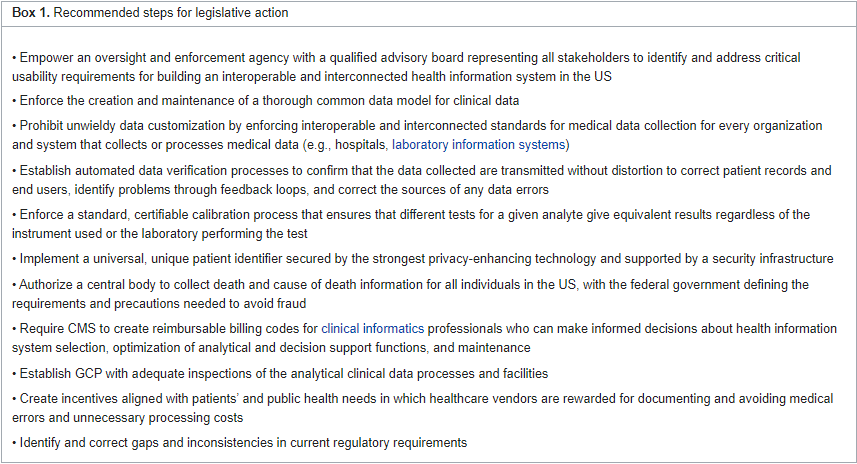Difference between revisions of "Template:Article of the week"
Shawndouglas (talk | contribs) (Updated article of the week text) |
Shawndouglas (talk | contribs) (Updated article of the week text.) |
||
| Line 1: | Line 1: | ||
<div style="float: left; margin: 0.5em 0.9em 0.4em 0em;">[[File: | <div style="float: left; margin: 0.5em 0.9em 0.4em 0em;">[[File:Box1 Szarfman CommMed22 2.png|240px]]</div> | ||
'''"[[Journal: | '''"[[Journal:Recommendations for achieving interoperable and shareable medical data in the USA|Recommendations for achieving interoperable and shareable medical data in the USA]]"''' | ||
Easy access to large quantities of accurate health data is required to understand medical and scientific [[information]] in real time; evaluate public health measures before, during, and after times of crisis; and prevent medical errors. Introducing a system in the United States of America that allows for efficient access to such health data and ensures auditability of data facts, while avoiding data silos, will require fundamental changes in current practices. Here, we recommend the implementation of standardized data collection and transmission systems, universal identifiers for individual patients and end users, a reference standard infrastructure to support calibration and integration of [[laboratory]] results from equivalent tests, and modernized working practices. Requiring comprehensive and binding [[Technical standard|standards]], rather than incentivizing voluntary and often piecemeal efforts for [[data exchange]], will allow us to achieve the analytical information environment that patients need ... ('''[[Journal:Recommendations for achieving interoperable and shareable medical data in the USA|Full article...]]''')<br /> | |||
<br /> | |||
''Recently featured'': | ''Recently featured'': | ||
{{flowlist | | {{flowlist | | ||
* [[Journal:Can a byte improve our bite? An analysis of digital twins in the food industry|Can a byte improve our bite? An analysis of digital twins in the food industry]] | |||
* [[Journal:Exploration of organic superionic glassy conductors by process and materials informatics with lossless graph database|Exploration of organic superionic glassy conductors by process and materials informatics with lossless graph database]] | * [[Journal:Exploration of organic superionic glassy conductors by process and materials informatics with lossless graph database|Exploration of organic superionic glassy conductors by process and materials informatics with lossless graph database]] | ||
* [[Journal:Elegancy: Digitizing the wisdom from laboratories to the cloud with free no-code platform|Elegancy: Digitizing the wisdom from laboratories to the cloud with free no-code platform]] | * [[Journal:Elegancy: Digitizing the wisdom from laboratories to the cloud with free no-code platform|Elegancy: Digitizing the wisdom from laboratories to the cloud with free no-code platform]] | ||
}} | }} | ||
Revision as of 17:35, 1 May 2023
"Recommendations for achieving interoperable and shareable medical data in the USA"
Easy access to large quantities of accurate health data is required to understand medical and scientific information in real time; evaluate public health measures before, during, and after times of crisis; and prevent medical errors. Introducing a system in the United States of America that allows for efficient access to such health data and ensures auditability of data facts, while avoiding data silos, will require fundamental changes in current practices. Here, we recommend the implementation of standardized data collection and transmission systems, universal identifiers for individual patients and end users, a reference standard infrastructure to support calibration and integration of laboratory results from equivalent tests, and modernized working practices. Requiring comprehensive and binding standards, rather than incentivizing voluntary and often piecemeal efforts for data exchange, will allow us to achieve the analytical information environment that patients need ... (Full article...)
Recently featured:










